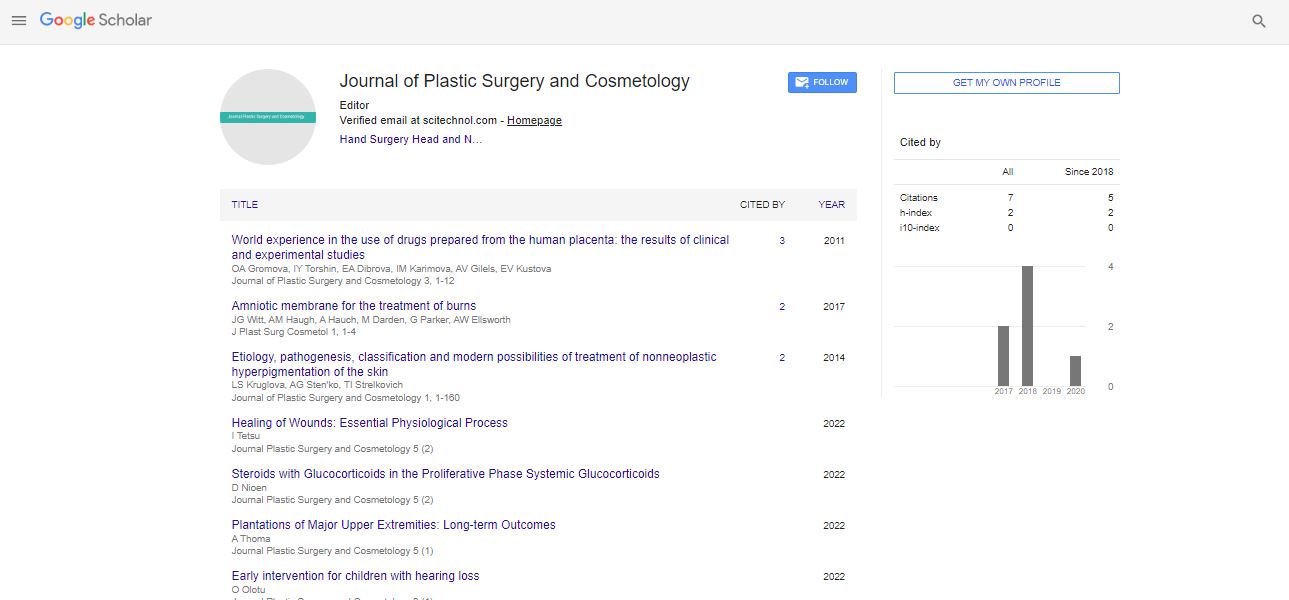Opinion Article, J Pls Sur Cos Vol: 12 Issue: 2
Craniofacial Surgery: Advancements and Clinical Applications
Meier Cercenelli*
Department of Anesthesiology, Medical College of Wisconsin, Children’s Hospital of Wisconsin, West Wisconsin Avenue, Milwaukee, USA
*Corresponding Author: Meier Cercenelli,
Department of Anesthesiology, Medical College of Wisconsin, Children’s Hospital of Wisconsin, West Wisconsin Avenue, Milwaukee, USA;
E-mail: Cerenelli010@htomail.com
Received date: 29 May, 2023, Manuscript No. JPSC-23-106765;
Editor assigned date: 31 May, 2023, PreQC No. JPSC-23-106765(PQ);
Reviewed date: 14 June, 2023, QCNo JPSC-23-106765;
Revised date: 21 June, 2023, Manuscript No. JPSC-23-106765(R);
Published date: 30 June, 2023, DOI: 10.4172/JPSC.100049
Citation: Cercenelli M (2023) Craniofacial Surgery: Advancements and Clinical Applications. J Pls Sur Cos 12:2.
Description
Craniofacial surgery is a specialized field that encompasses a broad range of surgical procedures aimed at correcting congenital and acquired craniofacial deformities. This study provides an overview of the advancements and clinical applications of craniofacial surgery. We discuss the historical evolution of craniofacial surgery, including the development of surgical techniques and the establishment of multidisciplinary teams. Various craniofacial anomalies, such as craniosynostosis, cleft lip and palate, and facial trauma, is explored, along with the surgical interventions available. Furthermore, we highlight the recent advancements in craniofacial imaging, virtual surgical planning, and tissue engineering, which have contributed to improved surgical outcomes. The study concludes with a discussion on the challenges and future directions in craniofacial surgery.
Craniofacial surgery is a complex and rapidly evolving field that involves the treatment of congenital and acquired deformities affecting Highlighting the historical context, surgical techniques, imaging modalities, and emerging technologies. Craniofacial surgery not only addresses physical deformities but also plays an important role in improving patients' overall quality of life. By correcting facial anomalies and restoring normal function, craniofacial surgery can enhance speech, breathing, swallowing, and social interactions, thereby positively impacting psychological well-being.
Clinical applications
Craniofacial surgery has evolved significantly over the years, driven by advancements in surgical techniques, imaging modalities, and interdisciplinary collaborations. Surgical interventions for craniosynostosis involve cranial vault remodeling or distraction osteogenesis. Cleft lip and palate repair techniques have also improved, leading to enhanced aesthetic and functional outcomes. In cases of facial trauma, craniofacial reconstruction aims to restore normal anatomy and function while optimizing esthetic results. Recent developments in craniofacial imaging, including 3D computed tomography and intraoperative navigation systems have facilitated accurate preoperative planning and improved surgical precision. Additionally, tissue engineering approaches hold hope for tissue regeneration and replacement in craniofacial defects. Advancements in imaging technology, such as three-dimensional Computed Tomography (CT) scans and virtual surgical planning, have revolutionized craniofacial surgery. These tools enable surgeons to accurately visualize the anatomy, plan the surgical approach, and simulate the anticipated outcomes before the actual procedure, resulting in improved surgical precision and patient outcomes.
Furthermore, advancements in tissue engineering and regenerative medicine hold efficacy for craniofacial surgery. Researchers are exploring innovative approaches to create custom-made craniofacial implants and regenerate tissues, facilitating more natural and longlasting reconstructive outcomes.
Craniofacial surgery requires a multidisciplinary team approach, including craniofacial surgeons, plastic surgeons, neurosurgeons, orthodontists, and speech therapists. Collaboration among these specialties ensures comprehensive and individualized care for patients with craniofacial anomalies. The advent of virtual surgical planning and 3D printing has revolutionized preoperative assessment and surgical simulation, leading to improved outcomes and reduced surgical morbidity. Furthermore, tissue engineering and regenerative medicine hold potential for generating customized craniofacial implants and tissues, further enhancing reconstructive options.
Conclusion
Craniofacial surgery has made significant advancements in recent years, benefiting patients with craniofacial anomalies and traumatic injuries. The integration of advanced imaging modalities, virtual surgical planning, and tissue engineering techniques has enhanced surgical precision and outcomes. Continued research and collaboration among various specialties will further drive progress in craniofacial surgery, leading to improved patient care and quality of life.
 Spanish
Spanish  Chinese
Chinese  Russian
Russian  German
German  French
French  Japanese
Japanese  Portuguese
Portuguese  Hindi
Hindi 